Understanding Pool Filtration and Circulation
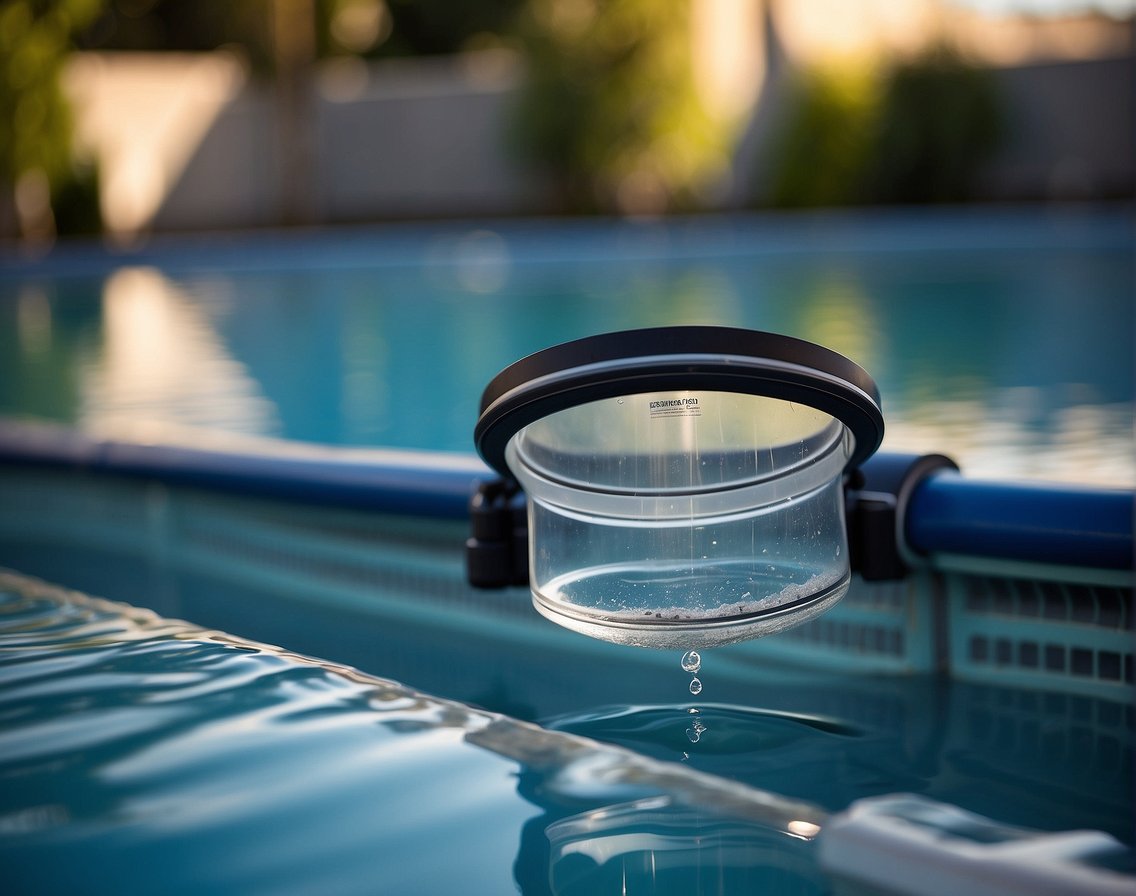
Maintaining clear and clean pool water demands a proficient understanding of both water circulation and filtration. It’s crucial to recognize that an effective system is key to a healthy swimming environment.
Essentials of Water Circulation
Water circulation is pivotal to ensure that the water in our pool remains crystal clear and sanitized. The pool pump is the heart of this process, propelling water through the filtration system. It’s our job to regularly check the pump’s operation, as its efficiency directly influences water quality. Good circulation helps distribute chemicals evenly and keeps pool water from becoming stagnant, which can lead to algae growth and debris accumulation.
Filtration System Components
The filtration system is composed of several key elements that work in unison to remove impurities from pool water:
- Filter Media: This is the material inside the filter that traps contaminants. Types of media include sand, cartridge, or diatomaceous earth.
- Pool Filters: Cartridge filters are easy to maintain and suitable for small to medium pools, while sand filters are cost-effective and require periodic backwashing to clean the filter media. Backwashing reverses the flow of water to purge the trapped dirt from the filter.
We should ensure that we choose the appropriate filter and maintain it according to the manufacturer’s guidelines to maintain optimal filtration efficiency. Regular inspection and maintenance of the filter are vital, including replacing filter media as needed to prevent any reduction in water quality or circulation effectiveness.
Maintaining Pool Water Chemistry
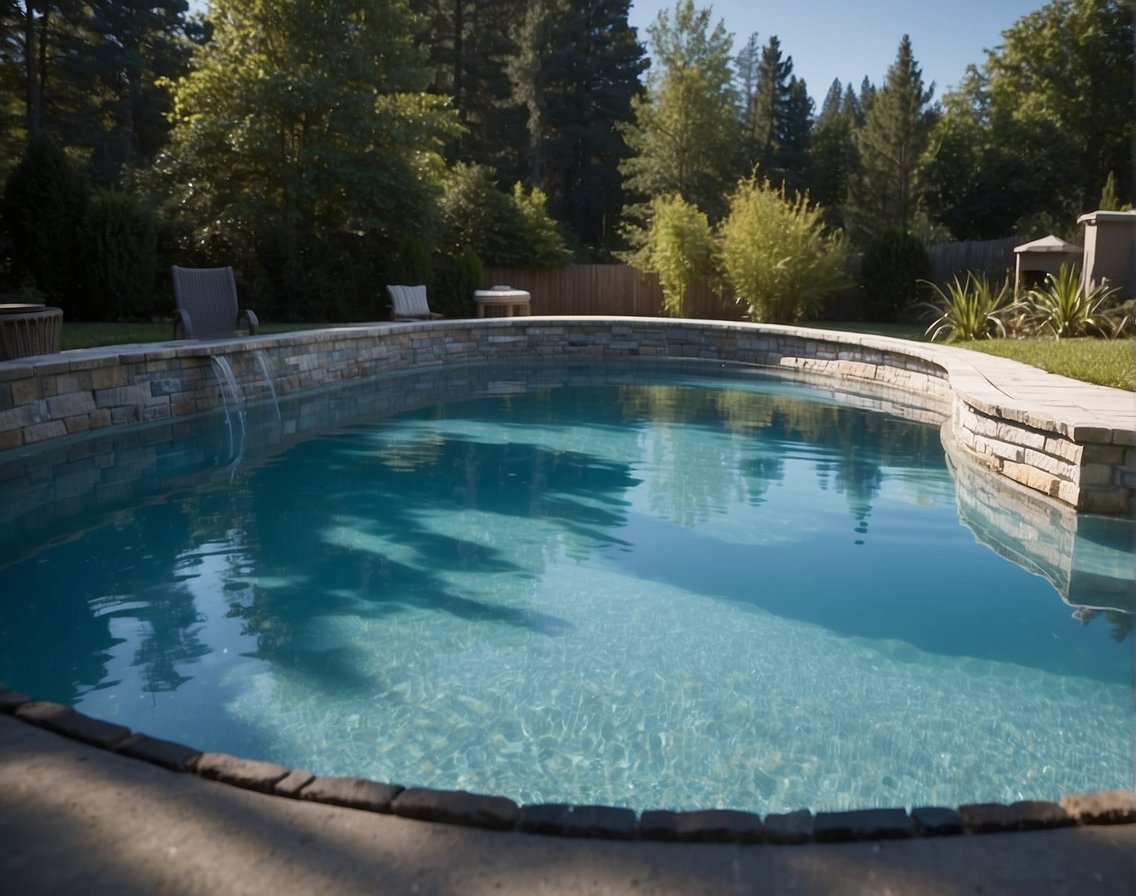
Maintaining the proper chemistry of your pool water is crucial for a safe and pleasant swimming experience. We’ll guide you through balancing pH and alkalinity, as well as managing chlorine and sanitizer levels, ensuring a healthy swimming environment.
Balancing pH and Alkalinity
The pH and alkalinity of your pool are the foundation of water chemistry. We aim for a pH level between 7.4 to 7.6 and an alkalinity level between 100 and 150 ppm (parts per million). To accurately assess these levels, regular water testing is essential. Test strips or a digital testing kit can be used for this purpose, with more frequent testing during heavy pool use or after significant rainfall.
- pH Levels: A pH level below 7.0 indicates acidity, which can corrode pool equipment and irritate skin. Above 7.8, the water becomes too alkaline, which can cause cloudy water and scaling. We adjust pH levels using pH increasers (like soda ash) or decreasers (such as muriatic acid or sodium bisulfate).
- Total Alkalinity: It acts as a buffer for the pH, helping to stabilize it. If alkalinity is too low, pH levels can fluctuate wildly; too high, and it becomes difficult to adjust the pH. We use baking soda to raise alkalinity and muriatic acid to lower it.
Managing Chlorine and Sanitizer Levels
Chlorine and other sanitizers are vital for killing bacteria and algae, keeping the water clean and safe. The ideal chlorine level is between 1-3 ppm. For other sanitizers like bromine, we follow the manufacturer’s recommended levels.
- Chlorine: We routinely check the chlorine levels using test strips or a test kit. If levels are low, we add chlorine, either in tablet, powder, or liquid form, to reach the optimal range. Shock treatments are used periodically to raise chlorine levels quickly and combat algae and bacterial contamination.
- Chemical Balance: In tandem with chlorine, we monitor calcium hardness and stabilizer levels (cyanuric acid for outdoor pools). The ideal calcium hardness level should be between 200-400 ppm to prevent plaster damage or cloudy water. A stabilizer helps prevent chlorine from being too rapidly degraded by the sun.
By keeping a close eye on these elements, we uphold a chemical balance that is not only conducive to clear and clean water but also safe for all swimmers’ health and comfort.
Comprehensive Pool Cleaning Techniques
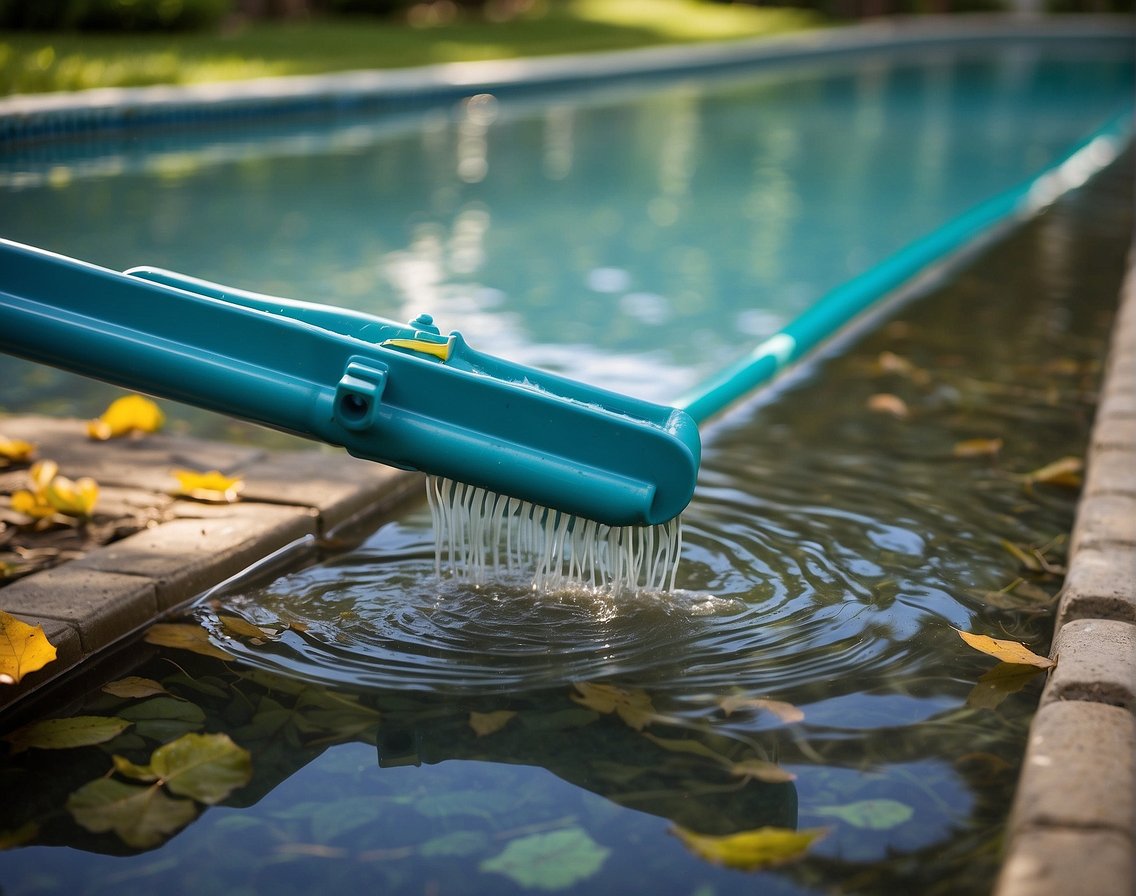
Maintaining a pristine swimming pool requires dedication to regular cleaning habits. We focus on two critical aspects of pool maintenance that ensure a healthy swimming environment: systematic skimming and vacuuming of debris, as well as thorough brushing of surfaces and the pool structure.
Skimming Debris and Vacuuming
Skimming is our first line of defense against contaminants. Daily, we remove leaves, insects, and other floating debris using a pool skimmer attached to a telescopic pole. This preemptive action aids in reducing the load on our pool’s filtration system.
- Skimming schedule: At least once daily
- Tools: Net skimmer, telescopic pole
For vacuuming, we utilize a pool vacuum to eradicate dirt and debris from the pool floor. This routine, performed weekly, prevents the accumulation of sediment, which can contribute to algae growth.
- Vacuuming frequency: Weekly, or more often if necessary
- Equipment: Manual or automatic pool vacuum
Brushing Surfaces and Pool Structure
We tackle stubborn contaminants such as algae and calcification through brushing. We ensure to use a pool brush affixed to a telescopic pole to scrub the walls, tiles, and nooks of our pool at least once a week. This dislodges algae and prevents buildup on pool surfaces.
- Brushing areas: Walls, floor, corners, steps
- Brush type: Stiff brush for plaster, softer for vinyl
Tiles often require special attention, and we meticulously clean the waterline tile to prevent calcium and scum build-up. Our brushing routine helps to keep the entire pool structure in excellent condition, free from unsightly marks and stains.
- Tile cleaning: Perform during brushing routine
- Focus: Waterline tiles to remove calcium deposits and scum
Ensuring Healthy Swimming Conditions
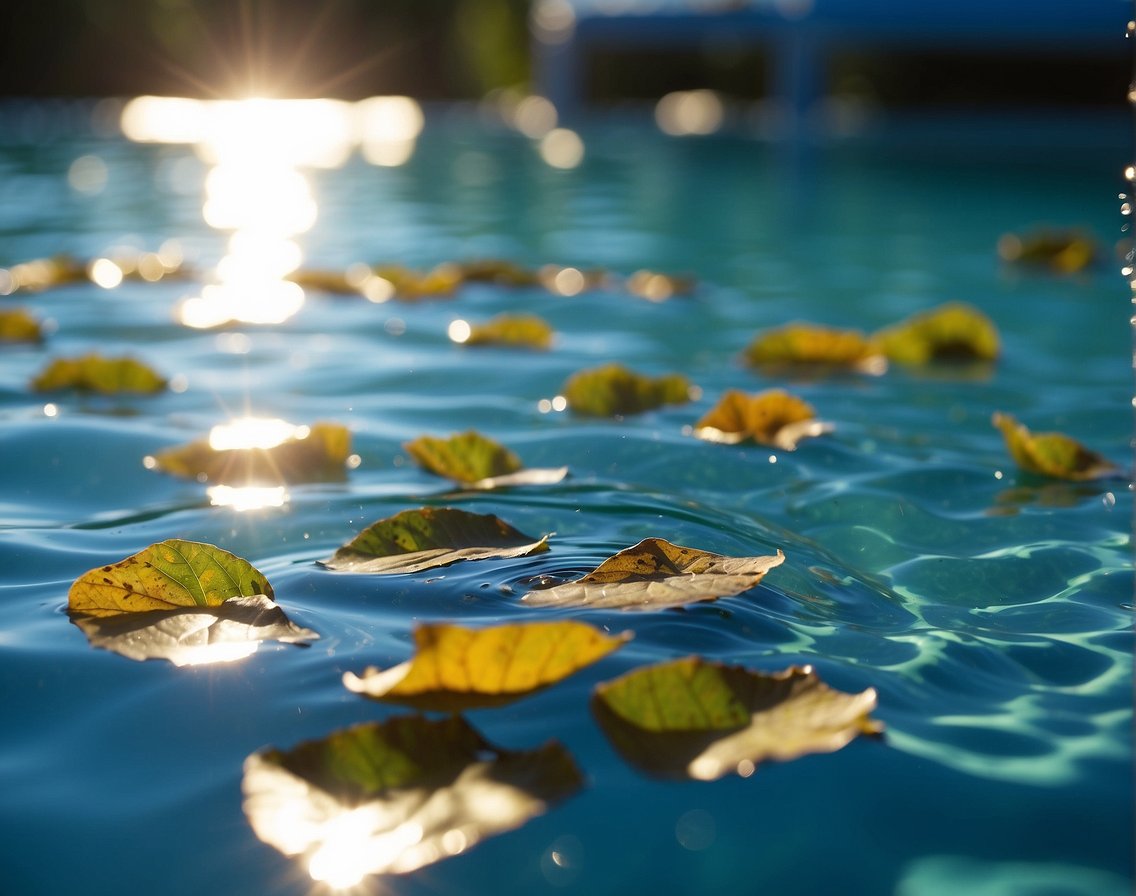
To maintain a healthy swimming pool, we focus on preventing bacteria and promoting safety. This ensures not only pristine water quality but also a superior swimming experience for all.
Preventing Bacteria and Illness
Regular pool skimming is critical to prevent bacteria and illness. Debris like leaves and insects can carry harmful microorganisms into the water.
- Skim Daily: We ensure to remove debris from the pool’s surface daily to minimize bacterial growth.
- Check Chlorine Levels: Chlorine effectively kills bacteria; we test levels frequently to maintain a range of 1-3 parts per million.
Consistent maintenance is key for a clean pool that’s safe from illness-causing bacteria.
Enhancing Swimmer Safety and Experience
A safe pool free from floating debris not only looks inviting but also safeguards swimmers from potential hazards.
- Visual Inspection: Before swimming, a quick visual check helps us identify and remove any objects that might harm pool-goers.
- Regular Cleaning Schedule: We adhere to a strict cleaning regimen, including skimming, vacuuming, and brushing, for a consistently healthy swimming pool.
By ensuring a clean and safe pool, we enhance the overall swimming experience.
Pool Maintenance Routines and Equipment Care
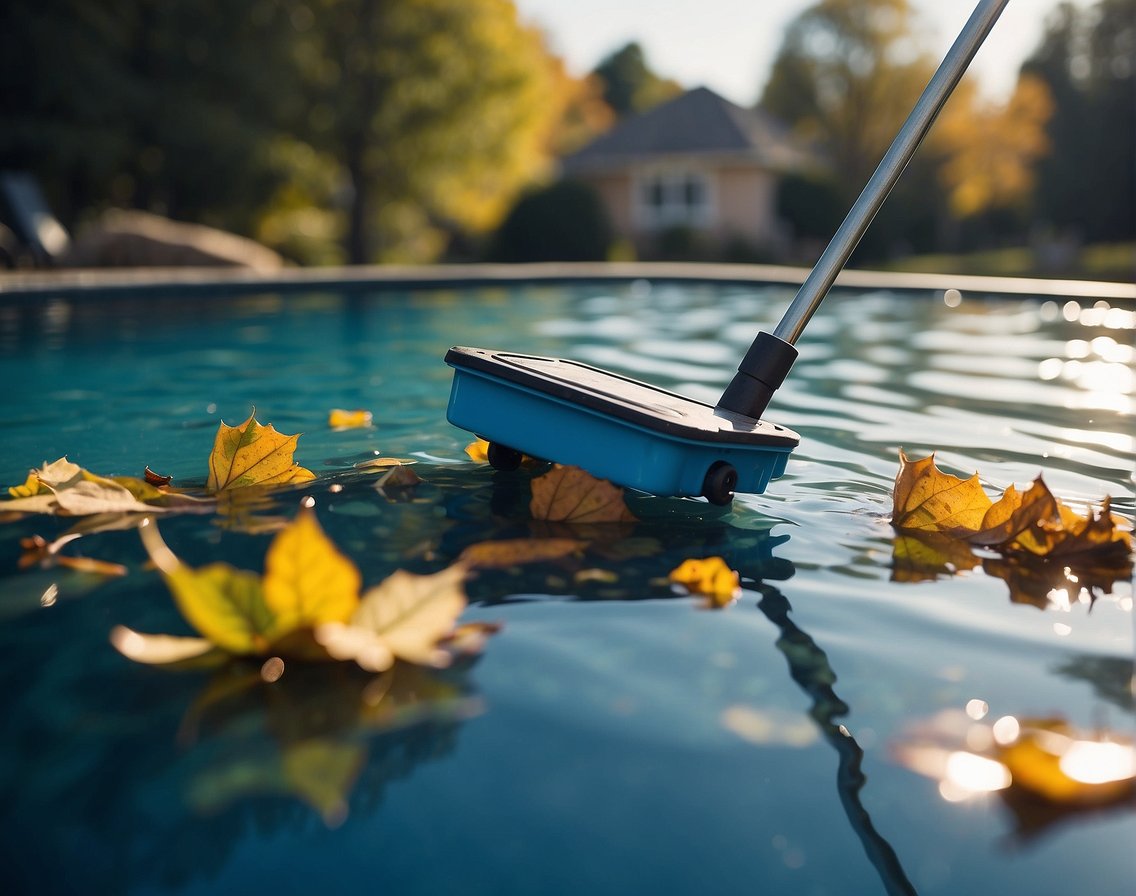
We understand the importance of maintaining a clean and healthy swimming environment. Proper routines and equipment care are key for both daily upkeep and long-term pool performance.
Daily and Seasonal Maintenance Routines
Daily pool maintenance is vital to ensure a crystal-clear swimming environment. Each day, we make sure to remove debris from the skimmer baskets to maintain proper pool circulation. Regular monitoring of the water level is also critical, ensuring it’s neither too high nor too low for efficient skimming action.
Daily Checklist
- Inspect and empty the skimmer basket
- Check the water level; adjust as necessary
- Skim the pool surface for floating debris
As the seasons change, comprehensive care is required to keep the pool at its best. During spring, a thorough cleaning and system check prepare the pool for heavy use. In fall, we advise winterizing, which includes balancing chemicals, lowering the water level slightly, and covering above-ground pools to protect them from the elements.
Seasonal Checklist:
- Spring: Clean pool, check equipment, balance chemicals
- Fall for Winterizing:
-
-
- Balance water chemistry
- Lower water level
- Cover the pool
-
Servicing and Upkeeping Pool Equipment
The longevity of pool equipment hinges on regular servicing and maintenance. We cleanse the pool filter according to manufacturer guidelines to prevent build-up that can lead to a cloudy pool. Routine maintenance on automatic pool cleaners ensures they operate efficiently and extend their lifespan.
Equipment Care Schedule
- Filter Cleaning: Follow the manufacturer’s recommended schedule
- Automatic Pool Cleaners: Inspect and service as per usage or as recommended
Considerations for Pool Equipment
- Regular servicing prevents costly repairs down the road.
- Keeping an eye on O-rings and seals can save on water loss and equipment strain.
By adhering to these maintenance routines and caring for equipment, pool owners can enjoy a clean and safe swimming environment all year round.
Frequently Asked Questions
Maintaining a swimming pool’s health involves routine skimmer maintenance and balancing water chemistry. We’ve compiled a list of common questions to guide you through this process.
What are the essential steps for maintaining a swimming pool skimmer?
To maintain your swimming pool skimmer, regularly clear debris from the skimmer basket, check for proper water level, and inspect the skimmer flap for any damage. It is vital to ensure that the skimmer is not hindered by obstructions to function effectively.
How frequently should pool skimming be performed to ensure a healthy swimming environment?
Pool skimming should be done at least once a day. However, during high usage or after storms, more frequent skimming may be necessary to remove leaves, insects, and other debris.
What is involved in the regular maintenance routine of a swimming pool?
Regular swimming pool maintenance includes skimming the pool’s surface, brushing the pool walls and floor, vacuuming debris, checking filter pressure, and testing water chemistry for sanitizer levels, pH balance, and alkalinity.
Can a pool’s pH level be maintained by the owner, and if so, how?
Yes, a pool’s pH level can be maintained by the owner. This involves using a water testing kit to measure pH, then adding either a pH increaser or decreaser to adjust the water’s acidity to the ideal range of 7.2 to 7.6.
Is it necessary to replace swimming pool water regularly, and what are the guidelines?
It’s not usually necessary to completely replace swimming pool water regularly. However, it should be partially replaced every five years or if Total Dissolved Solids (TDS) levels exceed 2500 ppm to maintain water quality.
What are the best practices for maintaining water clarity and hygiene in a swimming pool?
Best practices for maintaining water clarity and hygiene include keeping the pool’s chemical balance within the recommended levels, regular cleaning and skimming, backwashing the filter as needed, and shock treating the pool weekly to eliminate bacteria and algae.
